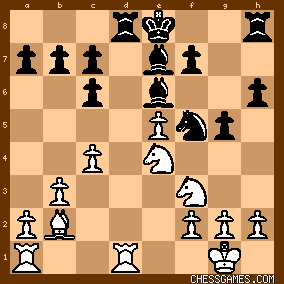| KEG: This short draw between two of the players at the bottom of the standings had some points of interest. 1. e4 e5
2. Nf3 Nc6
3. Bb5 Nf6
The Berlin Defense, which was then in vogue. This defense was the problem Gary Kasparov could not overcome in his 2000 match with Vladimir Kramnik. As in that match, it led to a draw here. 4. 0-0 Nxe4
5. d4 Nd6
6. BxN dxB
7. dxe5 Nf5
8. QxQ+ KxQ
The well-known position was now:

click for larger viewWhite has two advantages here: (i) the better pawn structure; and (ii) Black has lost the right to castle. In return, Black has the two Bishops. These generally balance out, and winning for either side has proved to be difficult. 9. Rd1+
Kasparov played the usual 9. Nc3 in his games against Kramnik, drawing every time during their 2000 match. Perhaps the most famous and noteworthy game that featured this position was the final round game between Bobby Fischer and Arthur Bisguier in the 1962-1963 US Championships. For once, Fischer had not pulled away from the field, having lost his first round game to Edmar Mednis. Going into the final round, he and Bisguier were tied for first, so this game decided the championship. Fischer, like Kasparov, played 9. Nc3 here. But unlike Kasparov, Fischer was able to win and thus took first place. The text (9. Rd1+) also has its points. Indeed, Nakamura played it against Topalov at London 2015 (the dame was drawn). 9. h3 is also frequently played here. 9... Ke8
10. b3
10. Nc3 is most frequently played here. Both moves are fine. Nakamura played the text in his game with Topalov. 10... h6
To prevent Bg5. The text is OK, but Black has other arguably better choices here: e.g., 10...Ne7; 10...Be6; and 10...Be7. Topalov played 10...Ne7. 11. Bb2
11. c4 immediately was more enterprising, but the text is also fine. 11... Be6
11...Be7 and 11...Ne7 and perhaps 11...b6 were also reasonable alternatives. 12. Nc3
While the text was fine for equality, 12. c4 was the best chance to mix things up and try to seize the initiative. The position was now:

click for larger viewThus far, the game had been carefully played by both sides. But neither side had made any real effort to play for a win and a dull draw seemed to be the result. But beginning here, the players seemed to throw caution to the winds and sought complications. 12... g5?!
12...Bb4 or 12...Rd8 are most precise, but promise only a boring draw. The text, however, even if not theoretically correct, created over-the-board complications. Suddenly, the board erupted. 13. Ne4
13. h3 to anticipate Halprin's intended attack may be best, but the text was a nice effort to exploit the weak squares Halprin's attack had created in the Black camp, especially f6 (but keep an eye on the d6 square!). 13... Be7
14. c4
Again bypassing the cautious (and arguably best) h3 in favor of fighting for control of the center and preparing for a possible assault on f6 or on the d-file. 14... Rd8
14...g4 seems indicated. Alternatively, he could have tried to ratchet up his King-side attack with 14...Rg8 The double-edged position was now:

click for larger viewAs I will discuss in my next post on this game, the climax was soon at hand. | 




